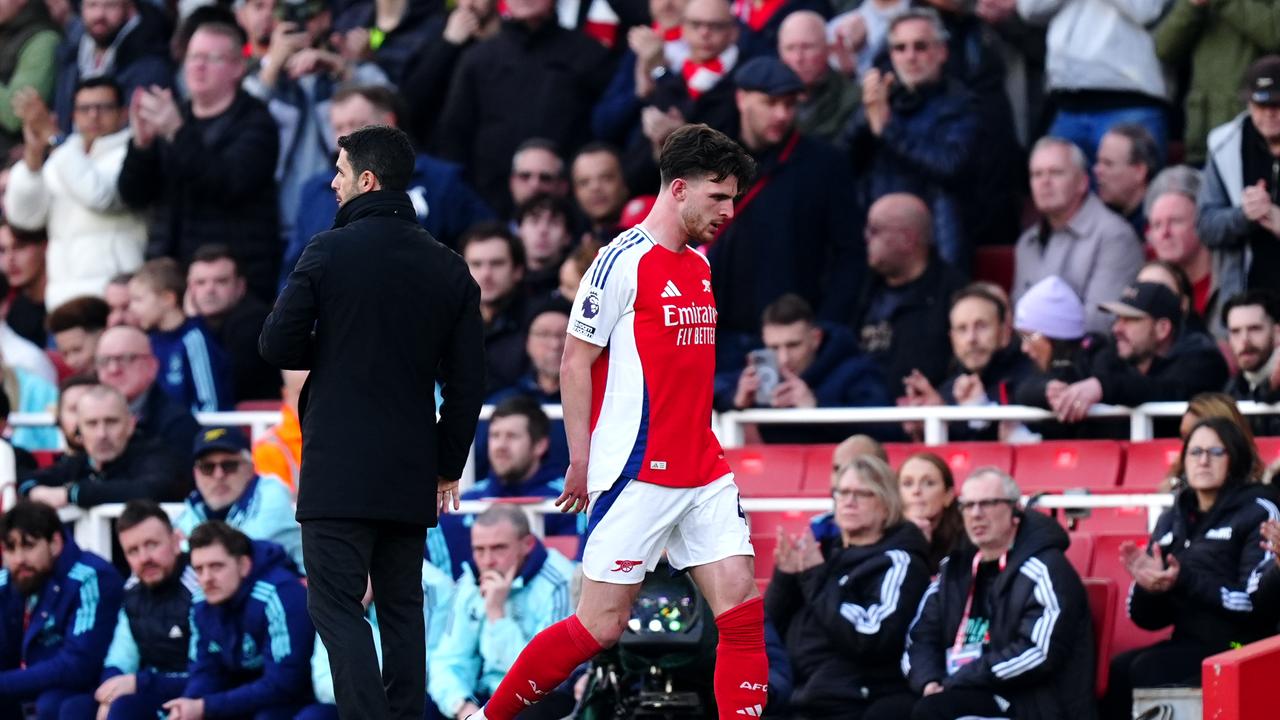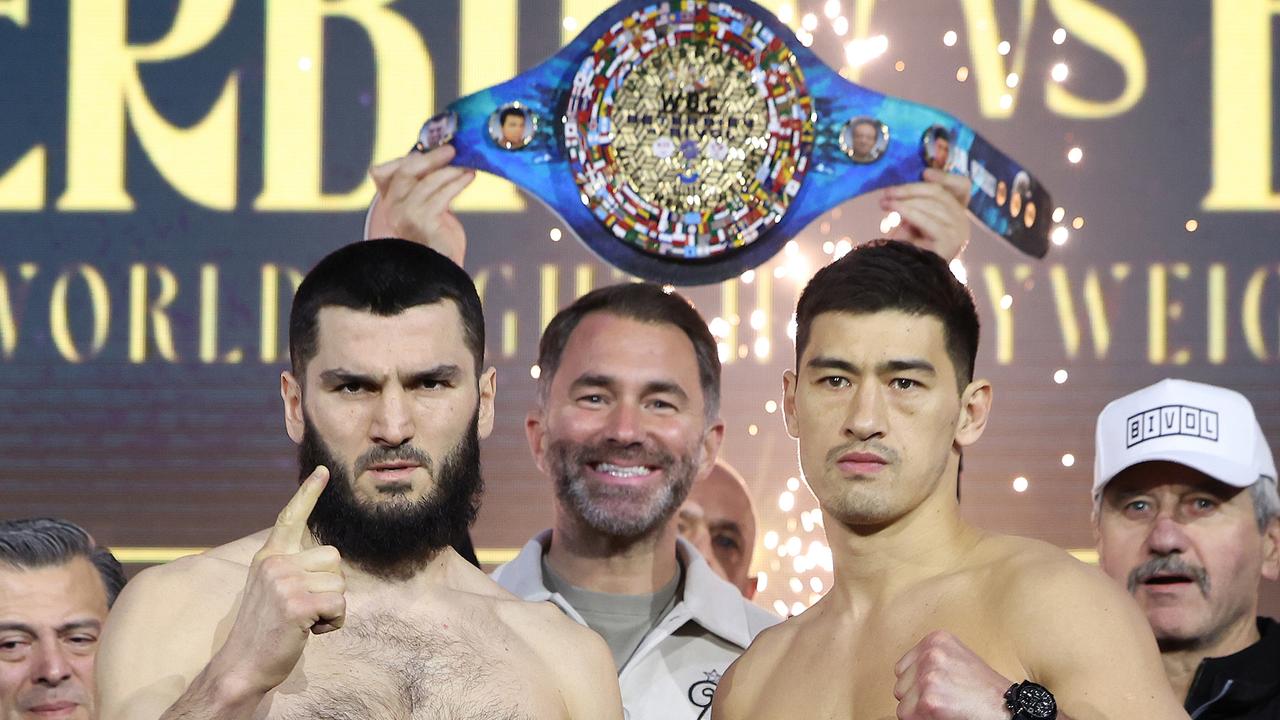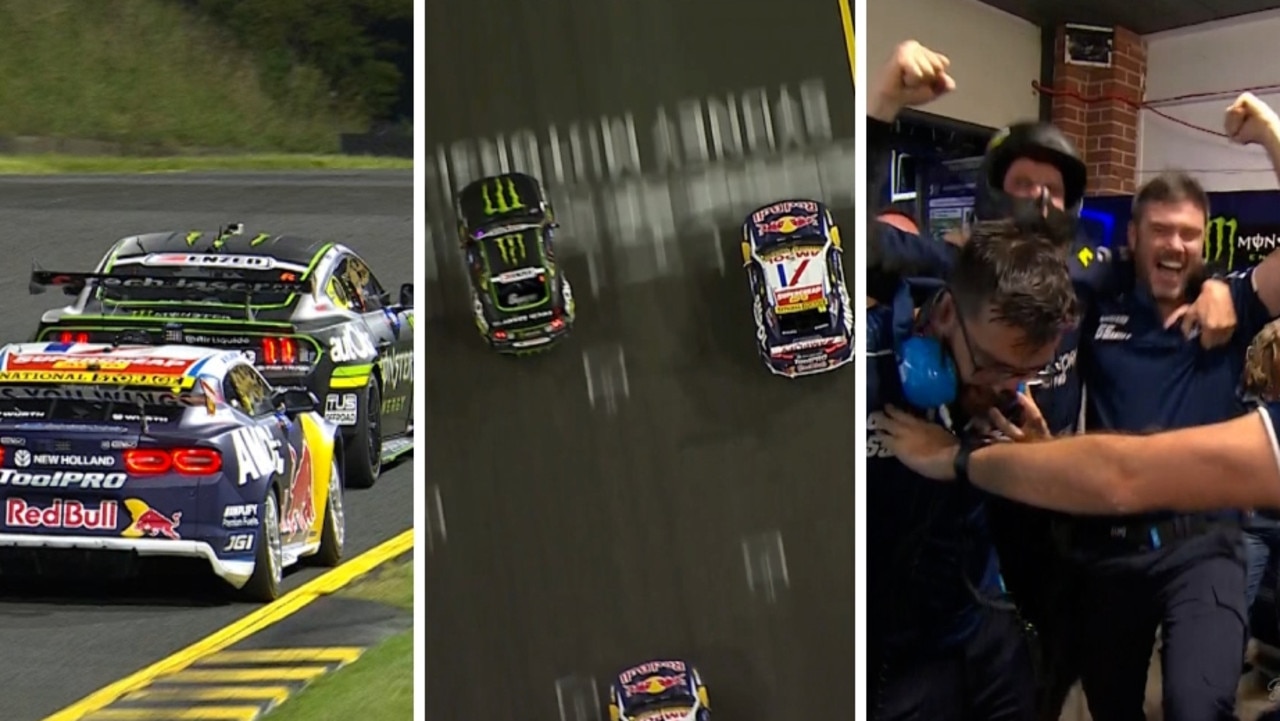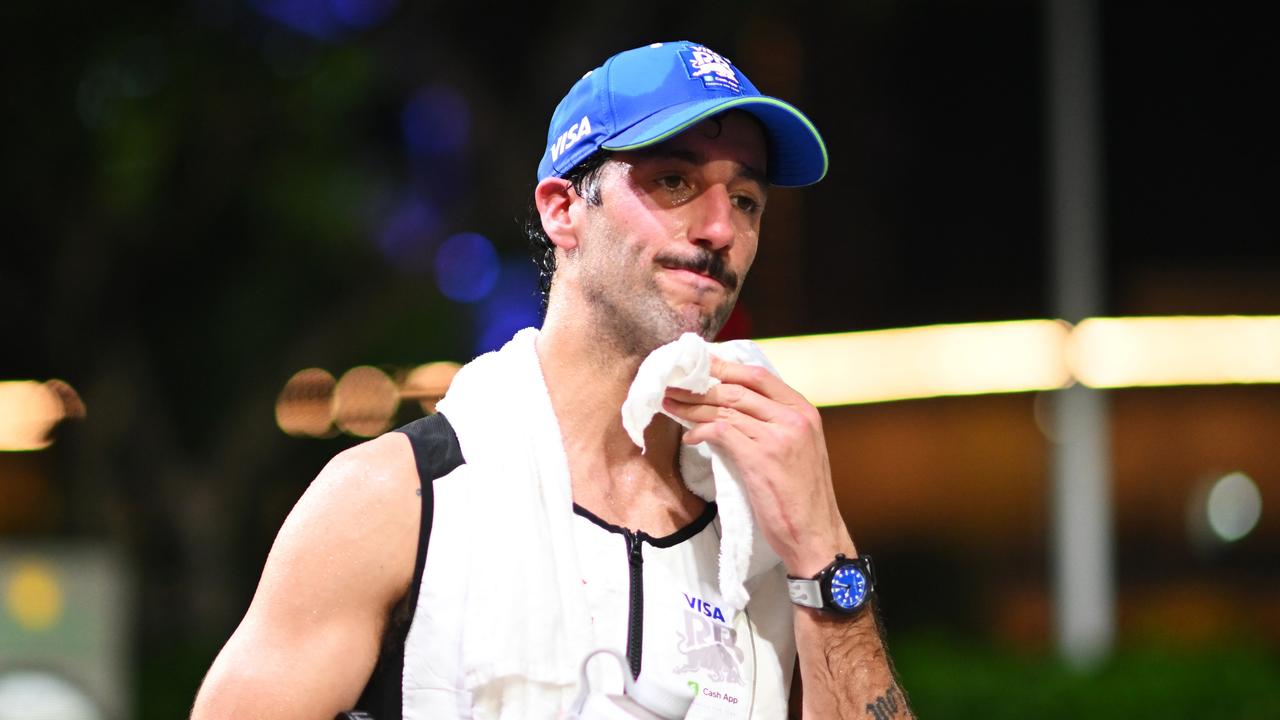What does a Christmas present for Daniel Ricciardo cost?
It rather depends on your perspective.
If you’re Red Bull owned RB, it’s worth nothing more than four soft tyres at a late-race pit stop, enabling the Australian to set the fastest lap of the Singapore Grand Prix and bow out of a long Formula 1 career on something of a high.
Every qualifying session and race from the 2024 FIA Formula One World Championship™ LIVE in 4K. New to Kayo? Start Your Free Trial Today >
If you’re McLaren, the price is tantamount to selling your sporting soul.
What might be the final action of Ricciardo’s grand prix racing career has brought a simmering point of tension back to boil, and with a live battle for both championships, the stakes couldn’t be any higher.
The context is innocuous enough.
Ricciardo was racing at the back of the pack after the unusual lack of a safety car had spoiled his strategy.
With nothing to gain in the race, he was brought into pit lane at the end of the third-last lap for a set of soft tyres to set the fastest lap.
It’s been seen countless times in Formula 1 since 2019, when the bonus point for fastest lap was reintroduced to the sport. If you can pit for fresh rubber on low fuel without costing yourself position, it’s a no-brainer to collect the extra score.
Except it’s almost never seen among drivers racing outside the top 10. Only drivers already in scoring positions are eligible to pick up the bonus point.
Ricciardo, therefore, gained nothing from the endeavour beyond a largely meaningless statistic.
But the fastest lap is a zero-sum gain, and Ricciardo setting it deprived Lando Norris the accolade — and, most importantly, the bonus point.
This was of direct benefit to sister team Red Bull Racing, which lost less ground to McLaren in the constructors championship, and to Max Verstappen, whose drivers title lead was dealt slightly less damage.
Crucially it allows Verstappen to win the title by finishing second to Norris for the rest of the year. Had Norris kept the bonus point, a perfect season would’ve still been enough to overturn Verstappen’s advantage.
“I don’t mean this against Lando, but part of me is hoping Max wins by one point, because I think I guaranteed myself a really nice Christmas present if so,” Ricciardo laughed to Sky Sports.
“Obviously it’s with a little bit of Red Bull in mind, but maybe to have one last crack at doing a fast one — if it’s to be it.”
PIT TALK PODCAST: Lando Norris’s dominant victory over title rival Max Verstappen is overshadowed by intense speculation that Daniel Ricciardo will be sacked from his RB seat, with reserve driver Liam Lawson waiting in the wings to take his place from the next race in Austin.
‘I WAS A LITTLE SURPRISED…’
Had Ricciardo been racing for any other team, there’d have been no questions over the team’s motivation to pit him.
“Given this may have been Daniel’s last race, we wanted to give him the chance to savour it and go out with the fastest lap,” team principal Laurent Mekies said in his post-race media statement.
But the fact RB has executed in a way that directly benefits Red Bull Racing has raised some serious questions.
Both teams are owned by Austrian energy drinks giant Red Bull.
CEO Peter Bayer even suggested earlier this year that the team name RB stands for Red Bull, though the company name is Racing Bulls.
No other teams in Formula 1 share ownership.
The situation was immediately suspicious.
“I did not see it coming,” McLaren principal Andrea Stella said, per Sky Sports. “I was a little surprised that the highest priority of Racing Bulls racing in Singapore was to go and score the fastest lap of the race.
“At the same time I have so much sympathy, support and friendship with Daniel that I’m just happy that he may add this fastest lap to his track record.”
Of course there’s nothing in the rules that would prevent RB from acting to benefit Red Bull Racing, and Stella was careful not to accuse the team of improper conduct.
“At no point do I have elements now to say Racing Bulls went for the fastest lap to support Red Bull,” he said. “I just find it a little peculiar.”
“As soon as you invoke the sportsmanship, I think you need to approach this with a sense of responsibility that I want to have.
“I don’t know the facts. I just saw that Racing Bulls went for the fastest lap and they achieved it.
“For me, talk about sportsmanship and so on, I think it would be out of place. I think we have to take it at face value that they scored the fastest lap.”
But Stella left no doubt that he found the situation uncomfortable.
“As part of a longer term conversation we need to put the sport in a position in which, at any stage — being it trackside or being it factory side — teams behave in a totally autonomous manner, because this is a constructors championship, a drivers championship; it’s not a coalition championship.
“Therefore this needs to be definitely addressed.”
‘I’m not crying, you’re crying….’ | 01:27
HOW HAS RED BULL ENDED UP WITH TWO TEAMS ANYWAY?
Red Bull’s joint team ownership is an anachronism dating back to the days of regular strugglers populating the grid.
“[Former F1 CEO] Bernie Ecclestone and [former FIA president] Max Mosley approached [Red Bullco-founder] Dietrich Mateschitz back in 2005 to acquire what was then the Minardi Formula 1 team that was perennially struggling, insolvent and on the brink of bankruptcy,” Christian Horner explained earlier in the year, when this issue began simmering again.
“Dietrich Mateschitz stepped in. He acquired the team and shored the team up, and obviously then he invested significantly in the Faenza facilities.”
At the time Toro Rosso was allowed to exist as a true customer team, running fundamentally the same car as Red Bull Racing. It even famously won the 2008 Italian Grand Prix with Sebastian Vettel, the first victory for the energy drinks brand in F1.
Since then, however, teams have been required to own the intellectual property to their chassis and aerodynamics, and RB has had to adapt to those rules to become a constructor in its own right.
“The regulations then evolved, obviously, and the Faenza-based team had to become their own manufacturer, and so further investment was made in the infrastructure in Faenza.
“The two teams are totally separate. One is based in Italy. One is based in the UK, the one that is based in Italy has a far larger turnover of staff that end up in Maranello than end up in Milton Keynes. They have different personalities, they have different characters and they comply continually with the regulations.
“Indeed the relationship is far less tight than some of the teams that enjoy very tight relationships with their engine manufacturers.”
But concerns extend beyond the technical relationship.
Red Bull owning two teams means it gets two votes on regulations and other matters.
The bizarre saga surrounding Ricciardo’s career, with neither team boss Mekies nor CEO Bayer appearing to know who will drive in that seat at the next race, also demonstrates ways in which RB isn’t fully independent.
The combination of longstanding goodwill for having saved a team — a team, mind you, that would be worth well north of $1 billion today — and satisfying the regulations as they’re written isn’t enough to placate McLaren CEO Zak Brown.
“No other sport to my knowledge allows co-ownership of two teams that compete against each other,” he said, per The Race, after Singapore.
“I think the sport, as we’re now in the budget cap era, has moved on to where we’re trying to have 10 independent teams from a sporting, from a political, from a technical point of view.
“I think they are very much playing by the rules. I have an issue with the rules, and believe the FIA needs to address this.”
‘WE ARE OVER-RESPECTING THE REGULATIONS’
There are two reasons the issue of Red Bull’s almost two decades of joint ownership are coming to the fore now.
The first is that RB is becoming more competitive.
In fact during pre-season testing there were fears the team had made the leap into the frontrunning pack and could have been competing for four or fifth with Mercedes.
While that ultimately didn’t come to pass, its form in the first third of the season did appear to have the team on trajectory to finish fifth ahead of Aston Martin, though a series of misdirected upgrades have meant it’ll now be lucky to cling onto sixth.
That’s partly a function of the entire field becoming more competitive in the era of the cost cap and development restrictions, but there have also been concerns since Red Bull confirmed publicly that it is strengthening the technical ties between the two teams, including by moving some of RB’s design office to the UK to be closer to Milton Keynes and, eventually, Red Bull Racing’s new wind tunnel.
That relates to the second key reason for worry.
Ironically, as the equalisation rules have been made more stringent, there’s been increasing speculation about exploitation of regulatory grey areas.
Early in the season this manifested in rumours that Red Bull Racing was sending staff to RB without gardening leave — unimaginable for transfers between other teams — which also would have helped the senior team to meet the budget cap without having to make surplus staff redundant.
“Unlike what you may have heard, the regulations are clear also for that,” Mekies hit back at the time. “You cannot use personal movement to go around the regulations of the IP of the technical parts.
“When we hire somebody from Red Bull we go to the FIA and we say, ‘We are planning to hire that person. You guys need to define what you feel the reasonable gardening leave is for that person’ and we stick to it.
“We are over-respecting the regulations and making sure that the FIA is on board on every single of these calls.”
Those rumours and others have since died down as RB has struggled for competitiveness. This has always been the case in Formula 1 — successful teams always receive heightened scrutiny from rivals — but it’s also because RB’s struggles have pushed it well outside Red Bull Racing’s sphere of performance.
The sister teams are rarely mentioned in the same breath other than when discussing driver movements. That’s largely been the case over the history of RB, which has never finished higher than sixth.
But the Singapore Grand Prix spectacularly reignited the debate, and with RB’s strategy having a material impact on the pointy end of the championship table, there’s scope for it to rumble on considerably.
Norris cruises to victory in Singapore | 02:57
WHERE TO FROM HERE?
The nightmare scenario for Formula 1 now could be that Norris loses the drivers championship by one point — or that Red Bull Racing miraculously wins the constructors title by a single point.
If you were a McLaren fan, you’d be understandably seething that Red Bull Racing, for one race in particular, had an extra dog in the fight.
Of course the counterargument is that Norris has already cost himself many more points off his own bat this season than the one he lost to Ricciardo at the weekend. He’s let fly 21 points just by failing to convert pole to victory three times this year, a far more compelling number.
It’s also fair to argue that the results of other teams have always played a role in the championship battle.
Norris was unlucky not just because Ricciardo pinched the point for fastest lap but also because teammate Oscar Piastri and Ferrari underperformed in qualifying. Had they started in a representative position, they almost certainly would have demoted Verstappen to fifth in the race for a 15-point swing in Norris’s favour regardless of the bonus point.
Teams also regularly deploy teammates against their own interested to influence the drivers championship battle. What will be more valuable to Red Bull Racing (or McLaren) — the one point Norris didn’t score, or the single point Sergio Pérez has scored over the last two weekends?
But just because RB’s late call in Singapore is unlikely to have a defining role to play in this year’s title fight doesn’t mean the issue will go away.
The pack is becoming more competitive every year. The rules reset in 2026 could see RB rocket up the order. In only a few seasons it could be regularly intervening in the battle for points in a way that meaningfully affects the title.
It seems attractively easy to say Red Bull should simply be required to divest, but Horner is right to argue that it invested at a time returns weren’t guaranteed and in a way that benefited the sport and saved jobs. That can’t be dismissed without consideration.
He also fairly points out that Red Bull has stuck with the sport when other large companies have abandoned it when the going’s got tough — in particular during the exodus of auto manufacturers during the 2008 financial crisis.
Red Bull also invests in F1 via promoting the Austrian Grand Prix at a circuit it owns.
Instead Red Bull should be incentivised to sell. With a Formula 1 entry so valuable given the sport’s booming popularity, there would be no shortage of genuine buyers who would be willing to continue the team’s legacy.
Given would-be new teams have been frequently encouraged to buy in rather than attempt to gain an 11th entry, F1 would evidently be motivated to make it happen successfully — in fact it would be the perfect situation for the sport, whereby it would gain a new owner without having to accommodate a new team.
In the meantime the regulations should be rewritten to ensure no future business can own more than one team to preserve the integrity of the sport in the future.
But like virtually everything in Formula 1, it’s easier said than done.





































Discussion about this post